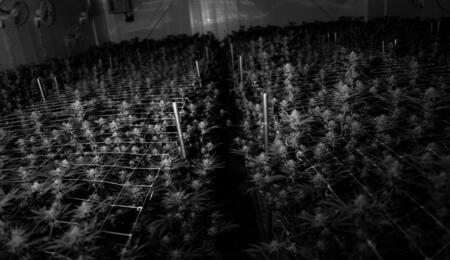California Crisis

There's no end in sight to the illegal pot market in California. The legalization of cannabis in California in 2016 came with a promise to downsize unlawful trade as well as reduce the violence and the environmental harm caused by criminal networks. However, despite the legalization, illegal farms are thriving on a scale never before seen in the Golden State.
As a result of the enormous scale of illegal cultivation, California's wholesale prices crashed last year, putting many small-scale legal farmers at risk of financial ruin. That being just one of many upshots created by the illegal pot market in California.
Cali's illegal farms continue to spread terror across the country. Rural communities are the most affected. Neighbors and land owners are frightened of heavily armed camps located in Mouth Shasta Vista, Sierra Nevada or the North Coast.
Criminal networks operate near immunity as they lease private property and quickly set up illegal plots with up to a hundred greenhouses. The overwhelming number of such sites is a challenge for the police. Even if they raid one farm and destroy all seized crops, the plots are back and running within a matter of days.
The raids may destroy illegal grows and detain underpaid laborers, but those responsible for the entire illicit farming schemes continue to evade justice. Under the veil of straw buyers and fake names on leases, criminals exploit the poor and the immigrants as working conditions remain lethal. Carbon monoxide poisoning has been linked to dozens of deaths of farm workers. Coroner reports further suggest some workers have also died in accidents in uninhabitable buildings.
That the crisis is unprecedented in its scope also tells us satellite imagery. Footage shows thousands of square miles of California dotted with what's believed to be illegal farming sites.
The satellite images indicate that illegal farms operate in some of the most expansive cultivation regions, including Trinity and Mendocino counties, and they outnumber licensed operators by as much as 10 to 1. At the northern end of Central Valley, California's Butte County attempted a ban on commercial cultivation. Regardless, the number of greenhouses in one area skyrocketed by 700% within five years. Another example is Lucerne Valley, where 13 illegal cannabis sites were located before legalization. In 2021, their number climbed to 935, according to the police.
The illegal trade boom has also changed the techniques how crops are cultivated. From annual harvests of outdoor crops, the underground market has now moved to covered polytunnels that can produce multiple rounds of crops yearly.
Farm workers are often exposed to unhygienic and even hazardous conditions and are frequently underpaid or not paid at all. Besides the inhuman treatment of workers, illegal farms are linked with substantial environmental damage, sometimes affecting unique biodiversity systems such as the Mojave Desert.
Farms are using unregulated chemical fertilizers and lethal pesticides as well as they are unlawfully depleting sources of groundwater. Water thefts proved to be an extremely worrying problem, especially as major droughts hit California in recent years. The events prompted officials at San Bernardino County to sponsor state bills that aim to increase fines for illicit farming and target entities that pollute or steal groundwater.
Proposition 64, the landmark legislation California voters approved in 2016, promised to end drug possession laws that disproportionally penalized the poor and people of color. However, as the decriminalization bill reduced criminal retributions, it also lowered the cost and risk of operating a business.
California has failed in managing the legal transition, not realizing that decriminalizing a vast, lucrative, illegal industry would fuel the ambitions of international criminal networks and opportunists. Outlaw grows have heightened cannabis-related violence, including shootings, robberies, kidnappings, and in some cases, homicide. Some residents have even said they are scared to venture onto their land.
While no comprehensive data on the illegal market scale is available, it is much larger than the licensed industry. One assumption is that California's illegal market generates anywhere near $8 billion each year. A sum greater than the $5.3 billion in taxed sales in 2021 from the commercial market established under Proposition 64.
Law enforcement is stretched thin in most areas where illicit farms flourish. State agencies have divergent priorities and inadequate resources for enforcing the criminal market. Water companies have been mapping and measuring the impact of cannabis cultivation in California for seven years, but the research has not yet been completed. Whether you can conclude one thing, it's that eradicating or at least downsizing the gray market has been a much bigger task than anyone has ever anticipated. Or, in the words of Mendocino County Sherriff Matt Kendall, "It's like taking on an army with a pocket knife."











